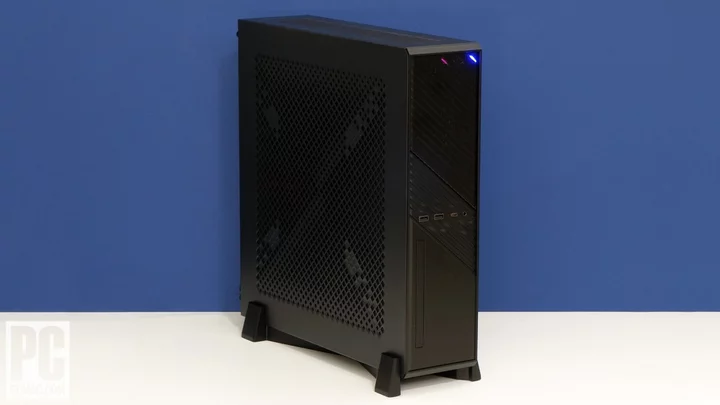Originally designed for the venerable home theater PC (HTPC) market, SilverStone’s Milo series of PC cases has shifted from parts designed to slip stealthily into a home entertainment media rack to horizontal/vertical convertibles that can go anywhere you might otherwise put a gaming console. That’s not to say you couldn’t put the company's versatile Milo 12 chassis in your office, but most of us don’t need space for a triple-slot graphics card in our office PCs. The $179.99 Milo 12 (technically, model SST-ML12B) appears to be designed for gaming, in addition to everything else that you might do with a slim Mini-ITX PC, but you'll want to be a bit wary of pushing performance (and thus, heat) too far in this tightly knit, slightly pricey box.
The Design: Less Is Less
The Milo 12 weighs only 11 pounds, so we expected little more than a basic case with its slots turned sideways to enable a slimmer profile. SilverStone surprised us by flipping several features around so that our initial photographs showed the case upside down. But that was pretty much the only surprise added to its plastic-faced, steel-shell construction.
(Credit: Thomas Soderstrom)The direction (up or down) is dictated by how SilverStone wanted to place the Milo 12’s power supply (bottom) and graphics card (top), and buyers can flip it around to a more familiar orientation of their choice. After all, flipping the case upside-down would correct the USB Type-A port orientation, and nothing in the design of the feet prevents this alternative.
(Credit: Thomas Soderstrom)The two vented side panels are identical and, despite appearances, not designed to be used on a VESA wall mount. While the blocked-in square may be designed to support the stand of a lightweight flat-panel monitor when using the case in its horizontal (classic "desktop") position, these panels are not reinforced for mounting, or for supporting anything heavier on top.
The rear panel, with its three expansion slots, I/O shield hole and adjacent vent, and power-supply extension socket, are also viewable from this angle.
(Credit: Thomas Soderstrom)Laying the Milo 12 on its left side exposes the motherboard tray and power-supply bay. There’s only room for Mini-ITX boards, but the power-supply bay supports both PS/2-casing ATX12V and SFX/SFX-L supplies up to 185mm deep including cables. (SilverStone rates the depth at 165mm, but that might have been a casing suggestion that left 20mm allowance for cable bends.) Two 2.5-inch drive trays are found atop the space adjacent to the motherboard, and a third 2.5-inch drive bay occupies an inset on the front of the case. Beneath the front 2.5-inch bay is the slot for a slim optical drive that sits behind the power-supply bay.
(Credit: Thomas Soderstrom)An SFX adapter fits inside the larger power-supply bay, but the fact that some of its screw holes aren’t reachable means that adding any power supply begins with, at a minimum, pulling the adapter tray out to either mount an SFX-L unit to it or to put an ATX12V (PS/2-sized) unit in its place. A fourth 2.5-inch drive tray is located between the power-supply bay and the back of the case, behind the power supply's extension cable.
(Credit: Thomas Soderstrom)Flipping the Milo 12 so that the motherboard compartment is upside-down reveals the graphics-card compartment in all its triple-slot-thickness glory. Fitting the case with an 80mm fan mount up front, SilverStone says that it supports graphics cards up to 345mm long. The narrowness of the gap in the tray behind the fan mount combines with the mount’s inset screw holes to limit fan thickness to a mere 15mm, which we think is silly since all of our 80mm fans are 25mm thick. Regardless of fan presence or thickness, the combination of GPU length and fan thickness needs to fit within the 355mm distance between the front and rear panels.
(Credit: Thomas Soderstrom)Worried about dust control? So were we! The Milo 12 features permanently attached filters on the side panels (held in by adhesive) and front panel (by folded tabs), and leaves the ends (top and bottom in tower orientation) unfiltered as exhaust vents. Oh, and in case you were wondering about adding a slim optical drive, the bay cover unsnaps from the inside, and you can do that if you're still on the CD train.
(Credit: Thomas Soderstrom)Building With the SilverStone Milo 12
The Milo 12 is packed with an unusual accessory set. You get a flexible GPU riser cable and installation screws to affix one end of the riser apparatus to the case. The chassis vertical stand is the big plastic "X" you see here, along with four half-inch-thick, self-adhesive rubber feet (they're hemispheres) for sticking on the corners of the left side panel when using the system in horizontal orientation.
(Credit: Thomas Soderstrom)Two screws and a tab are included for securing the back of a slim optical drive to the portion of the motherboard tray that runs under the power supply. Also in the box: five ratcheting cable ties, and a pack of screws for affixing internal components.
The interior header cables include a front-panel button/LED group, HD Audio for the front panel's combo audio jack, a USB 3.2 Gen 2x2 header for the Type-C port, and a USB 3.2 Gen 1 header for the two Type-A ports.
(Credit: Thomas Soderstrom)We ditched the Milo 12’s SFX adapter plate in favor of the one that came with our own SFX power supply, and used the case's optical drive bay as a handy cable path for both the ATX and ATX12V (EPS/EPS12V) leads. Our CPU cooler cleared the side panel by a little more than a quarter-inch, but a gap more than an inch in width separated our graphics cooler from the side panel. All cool there...at least in terms of fitment.
(Credit: Thomas Soderstrom)Our most recent case-testing parts mix fits nearly anything with even a single 120mm fan mount, but the Milo 12 doesn’t reach that installation minimum. Digging through a pile of older slim CPU coolers to find one with enough power for our mildly overclocked Core i5 we use for case thermal and acoustic testing, Scythe’s Big Shuriken 2 Rev. B stood out as having a large enough sink but too little fan, and its KazeFlex 120 fan would give us the extra airflow we needed. While our original RGB memory turned out to be too tall to fit under the alternative CPU cooler, Crucial’s new Pro Series DDR4-3200 provides the reduced profile needed to clear its overhang.
(Credit: Thomas Soderstrom)Our system initially tested cool enough to run our original 4.8GHz overclock, but putting it in the case turned it into a heat monster. We dropped the frequency by 200MHz and voltage by 50mV to bring things back under control. Here's a breakout of all the bits we used...
We wanted to be as fair as possible in testing the Milo 12, but we don’t have any recent cases with similar cooling limitations to compare. So, we pulled the panels off to find out how well our test system performed in the Milo 12’s vertical orientation, then put all the panels back on to find out how much the case would restrict cooling to the key components.
Testing the SilverStone Milo 12: Hot Stuff
No, your eyes are not deceiving you: These are temperature deltas for the Milo 12, not the full reading. (Good thing the room was cool?) Putting the Milo 12’s side panels back on pushed our CPU temperatures 10 degrees C further into the toasty zone compared with the same system completely opened.
Our voltage regulator temperature, meanwhile, was "only" 8 degrees C hotter with the case closed than open.
GPU temperatures rose by a full 13 degrees C after closing the case. The larger impact when compared to CPU temperatures is probably due, in part, to the greater distance between the GPU's cooler assembly and the Milo 12's side panel.
Surprisingly, we didn’t measure an SPL difference between the closed and open configurations, at least when listening from the front/right corner. The left side panel appears to have a little more effect on reducing GPU noise, but not much.
An ideal case would help to deliver cool air to components while also helping to block in the noise of those components' fans, and we haven’t seen an ideal compact case yet. Conversely, the Milo 12 has little impact on noise but takes a terribly high toll on temperatures, when compared to the same components, in the same position, in open air.
The Verdict: Find a Way to Keep Your Cool
We should probably treat the Milo 12 as a modernized version of an HTPC case and not a compact gaming beast, since our tests show that it isn’t very well suited to housing highly stressed midrange gaming hardware. While it seems a shame to limit a case with so large a graphics-card bay to such menial work, the presence of four 2.5-inch drive bays means that it’s at least designed to fill that classic HTPC role with abundant local storage. This isn't your ideal compact gaming case by a long shot, but you can whoop it up with CDs, DVDs, and locally stored media to your heart's content, and party like it's the early 2000s.









